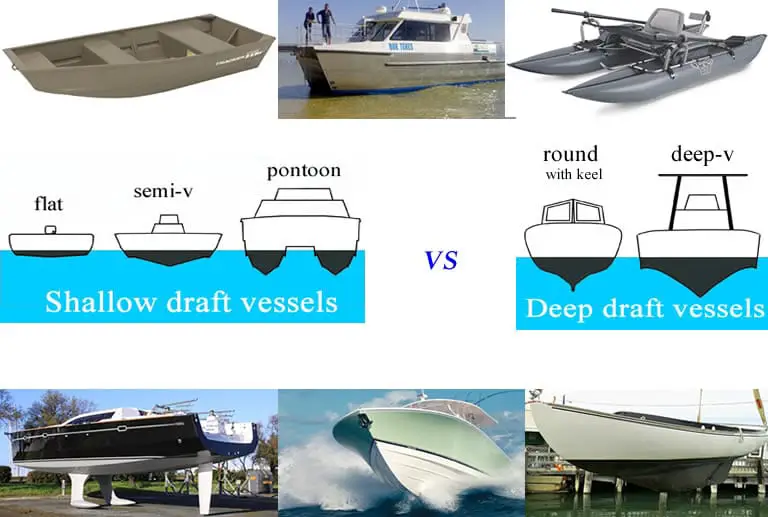But what on earth do these terms mean and which one is best for you?
Contents
Boat draft – shallow vs deep vs shoal
Shallow draft and deep draft refer to the depth of the lowest part of a boat.
A shallow draft boat has a bottom that lies not far below the waterline and is usually flat with no keel.
Deep draft refers to a boat with a bottom that lies much further below the waterline. However, a deep draft boat’s lowest point may be a keel that lies even lower in the water.
Shoal draft can be considered a hybrid design of shallow and deep draft boats.
Each draft type has advantages and disadvantages which I cover below.
Shallow draft vs deep draft vs shoal draft
For people new to boating the vast amount of features in boat design that are available can overwhelming and making a choice between those designs can be a daunting task.
Although there are an array of different features available on different boat types by far the most important choice you will make as a new boat owner is deciding between a boat with a shallow draft or one with a deep draft.
Why?
Because the choice you make will determine where you can use your boat.
Not all boats can navigate the same waters!
The draft of a boat determines where it can be used.
The draft of a boat is usually determined by how deep in the water the bottom of the boat sits.
Although it is usually the bottom of the boat that determines its draft sometimes additional things need to be considered.
For example, if a boat has a fin keel that extends much lower than the boat’s bottom then this will determine the boat’s draft rather than the bottom of the hull. Don’t worry, this will all make more sense as you progress through this article.
To understand the difference between deep draft and shallow draft I will give a brief explanation of what each one is, along with its advantages and disadvantages.
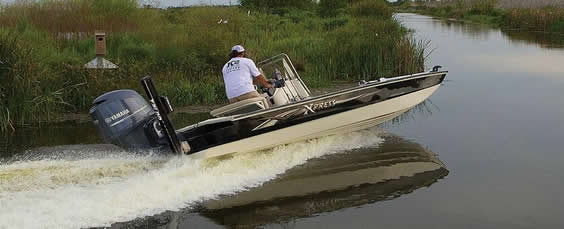
Shallow draft explained
I’ve already mentioned that draft refers the depth of the lowest point of a boat. So, what is shallow draft?
On a shallow draft boat this is almost always the boat’s bottom as a shallow draft boat will usually have a flat bottom with no keel. There are exceptions, such as a keel on a shallow draft canoe, but these are not important for understanding the basic principles.
If we take a Jon boat as an example of a shallow draft vessel we can see that its hull design has a flat bottom.
This flat bottom sits just a few inches below the waterline.
In other words, there is only a few inches depth of water between where the boat meets the water and the bottom of the boat which means the boat has a very shallow draft.
The depth of the bottom of the boat is also uniform across the width of the boat and most of its length – thus forming a solid flat surface that basically sits on the water. This means a shallow draft boat can navigate very shallow waters. Very shallow draft boats, like a Jon boat, can navigate waters that are only a few inches deep.
Advantages of a shallow draft boat
If you haven’t realized already there are some key advantages to having a boat with a shallow draft.
The 2 major advantages of having a shallow draft boat are:
- In calm water the flat bottom hull makes the boat exceptionally stable and comfortable to ride in.
- The shallow draft allows the boat to navigate very shallow waters without the worry of snagging the boat on rocks or debris.
Disadvantages of a shallow draft boat
But as with everything in life there are cons as well as pros to having a boat with a shallow draft.
The 2 major disadvantages of having a shallow draft boat are:
- In choppy water and windy conditions the boat can become unstable.
- The boat is not seaworthy. It can only be used in the ocean close to the shoreline and in optimal weather conditions. A shallow draft boat cannot handle waves. In strong winds and choppy ocean water it will almost definitely capsize. There are exceptions such as a catamaran and some Jon boat owners take their vessels on the ocean but for the most part shallow draft vessels are not seaworthy.
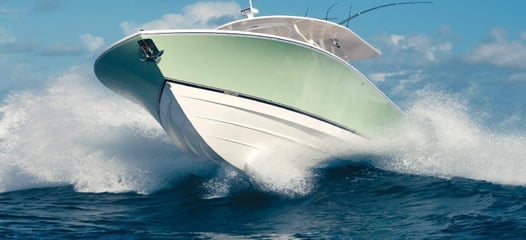
Deep draft explained
What is deep draft?
Deep draft refers to a boat that sits much deeper in the water.
Although a boat with a deep draft will have a hull bottom that sits lower in the water than a shallow draft boat, the bottom of the vessel may not always be the boat’s lowest point. A keel may extend much deeper into the water to offer a seaworthy vessel more stability in very turbulent water thus creating an even deeper draft.
Just like a shallow draft boat has advantages and disadvantages so too does a deep draft boat.
Advantages of a deep draft boat
Deep draft vessels have some key advantages over a shallow draft vessel.
The 2 major advantages of having a deep draft boat are:
- The boat very stable in choppy waters.
- The boat is seaworthy and can easily handle waves, thus allowing you to go in the ocean regardless of the conditions.
Disadvantages of a deep draft boat
Of course there are disadvantages to owning a deep draft boat as well.
The 2 major disadvantages of having a deep draft boat are:
- A deep draft boat is not as comfortable to ride in.
- A deep draft boat is restricted to deep waters such as the ocean or very deep lakes and therefore is not suitable for most inland waterways.
Shoal draft explained
There is also something known as shoal draft.
Boats with shoal draft are much less common than the other two types.
A shoal draft boat is one which has a shallower draft than other boats of comparable size.
To read more about shoal draft read my article on the topic here.
Advantages of shoal draft
When you want the best of both shallow and deep draft worlds then a shoal draft boat is what you need.
The 2 major advantages of having a shoal draft boat are:
- The boat can be used to navigate through shallower bodies of water than a standard deep draft ocean-going vessel. This allows the boat access to the shoals or shoreline.
- The keel is long enough to provide a safe trip across deep open waters such as the ocean.
Disadvantages of shoal draft
Of course there are also disadvantages to owning a shoal draft boat.
The 2 major disadvantages of having a shoal draft boat are:
- The boat does not have as much stability, especially in very choppy water, as a deep draft vessel. Ocean sailing is not as safe or comfortable as it would be in a deep draft boat.
- Access to the shallows is limited. although a shoal draft boat can gain access to shallower areas than a deep draft boat, most inland waterways are too shallow for this craft.
How draft is determined by hull design
It is the lowest point of a boat, as it sits in the water, which determines whether a boat has a shallow draft or deep draft. But, although it may be the lowest point of the boat that determines its draft but this is not the only difference between shallow draft and deep draft boats.
Shallow draft boats and deep draft boats also have different hull designs.
Although you will come across variations to the hull designs shown in the image below, the five basic designs I have given will give you an idea of how the bottom of boats are constructed. The catamaran shown in the image is a special type of pontoon boat.
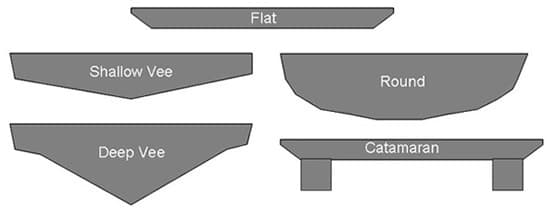
Shallow draft hull designs
The main contributing factor to the draft of a shallow draft boat is its hull design, specifically the bottom of the boat. This is because a shallow draft boat will almost never have a keel. A keel is designed to give a boat more stability in turbulent water and as a shallow draft boat is designed to be used on calm water a keel is unnecessary.
So, the lowest point of a shallow draft boat is almost always the bottom of the hull.
However, if you fit an outboard engine onto your boat then you must take into consideration the depth of the propeller when attempting to navigate shallow waters. Many Jon boat owners will keep some form of manual propulsion onboard, such as a paddle or pole, for use in very shallow waters or when approaching river banks etc.
A boat with the shallowest draft will always have a flat bottom.
A flat bottom gives a boat great stability in calm water and creates its shallow draft as the large surface area at the bottom of the boat forces the boat to “sit on” the water rather than to “sit in” the water.
However, not all shallow draft boats have a flat bottom. A pontoon boat has a fairly shallow draft which means it can access much shallower water than a deep draft boat like a v-hull for example. A semi-v hull boat, likewise, can access fairly shallow waters and navigate waters where a deep draft boat could not go. Its semi-v bottom gives it more stability in choppy waters than a flat-bottomed boat though.
However, neither a pontoon boat nor a semi-v boat can access the type of very shallow waters that a flat bottom boat can.
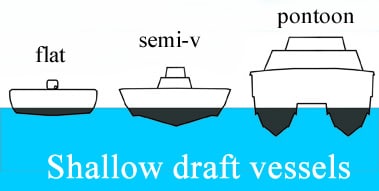
Deep draft hull designs
A seafaring boat, or one that regularly navigates choppy turbulent waters, needs much more stability for handling rougher waters. Obviously this means a flat bottom hull design would be unsuitable.
A deep draft boat will therefore have either a deep round bottom or a deep “V” shaped bottom so it sits deeper in the water.
Ocean going vessels will also usually be equipped with a deep keel to offer even more stability in very turbulent water.
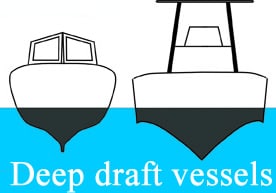
How to decide between a shallow draft, deep draft boat or shoal draft boat
If you are unsure about which draft type best suits your needs simply ask yourself this question:
Where will I use my boat?
Answering this question will let you decide which draft type is the best fit for you.
As you have already seen, navigating shallow rivers, streams and lakes requires a shallow draft boat while navigating open choppy water, like the ocean, requires a boat with a much deeper draft.
So, if you intend to stick to inland waterways for freshwater fishing, hunting or you just want to enjoy leisurely trips up and down rivers and streams then it is best to get a shallow draft flat bottom boat.
Inland waterways tend to be calm and have at least a few stretches of water, if not the entire waterway, that is too shallow for a deep draft boat.
On the other hand, if you plan to take to the ocean then a shallow draft boat is not a good idea. You will need a deep draft boat with a keel for more stability in turbulent waters.
If you want to have the option of deep open sea access but would also like to navigate the shoals or wish to hug the coastline tightly then a shoal draft boat is your best choice.

